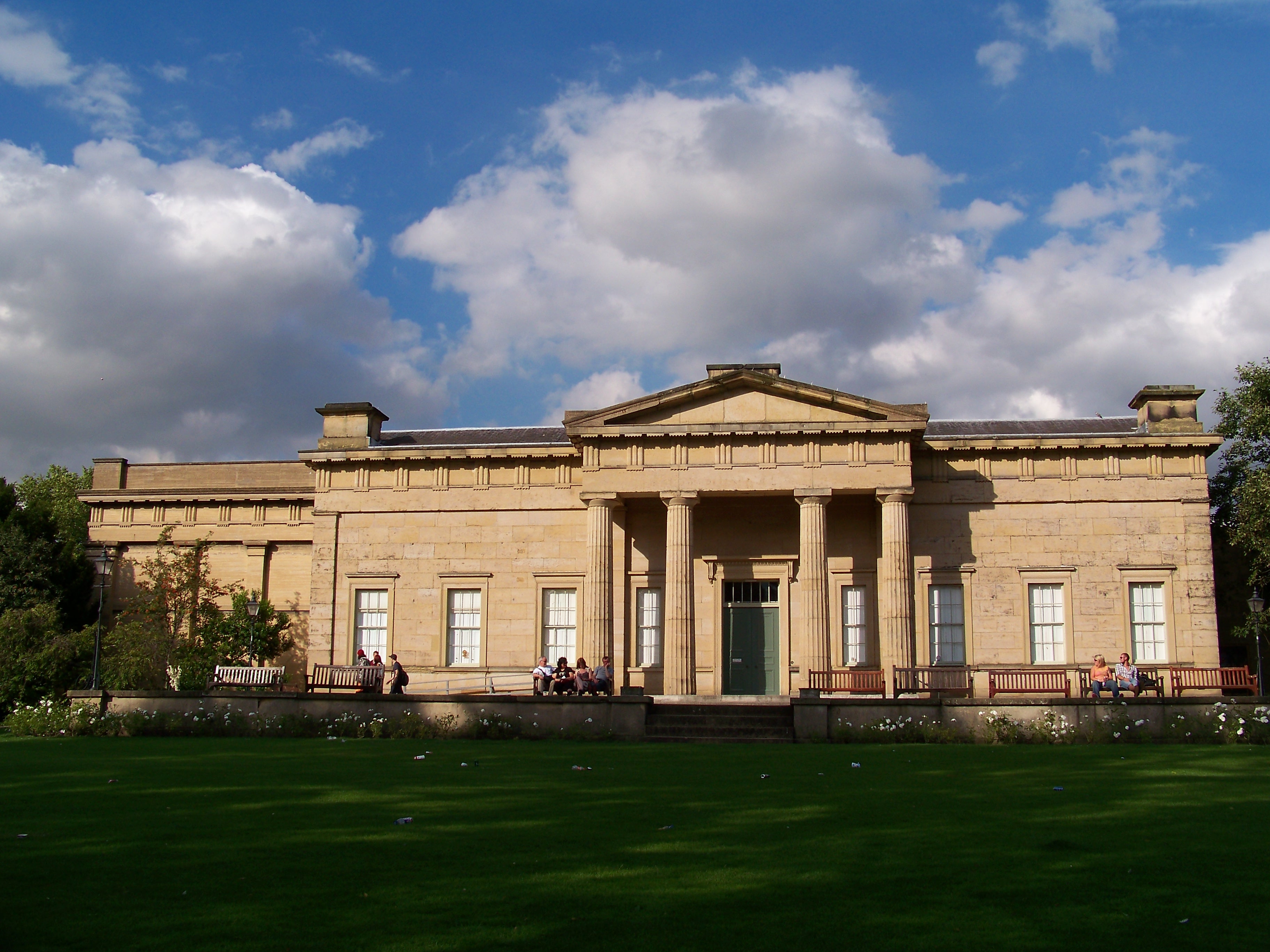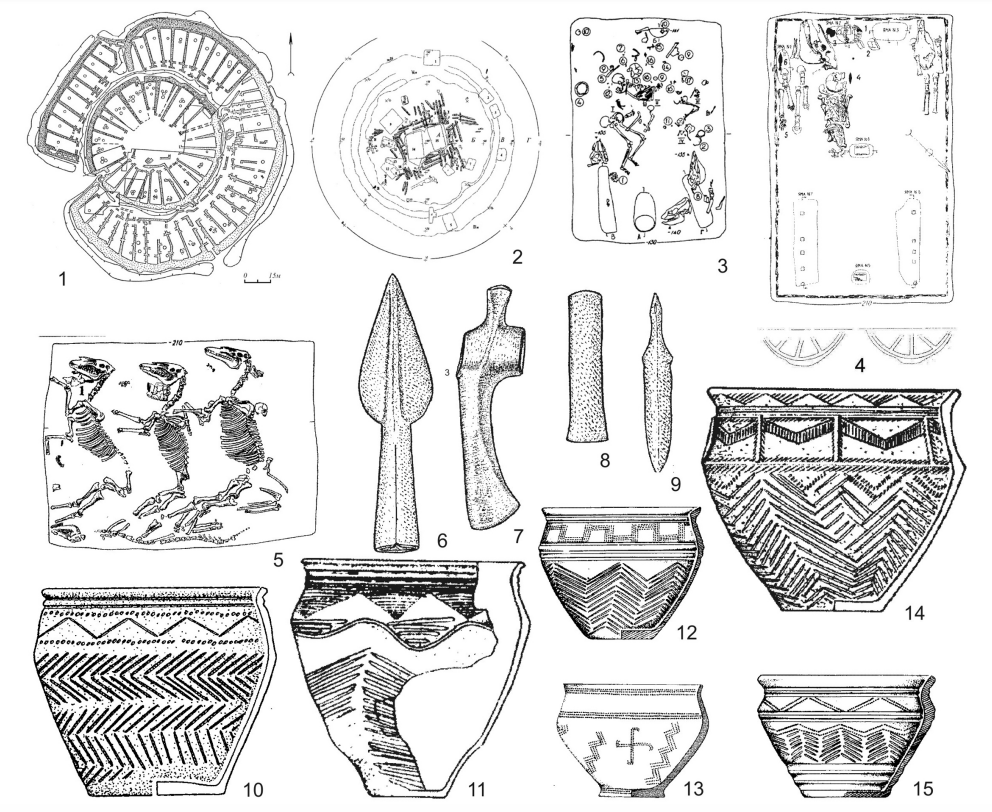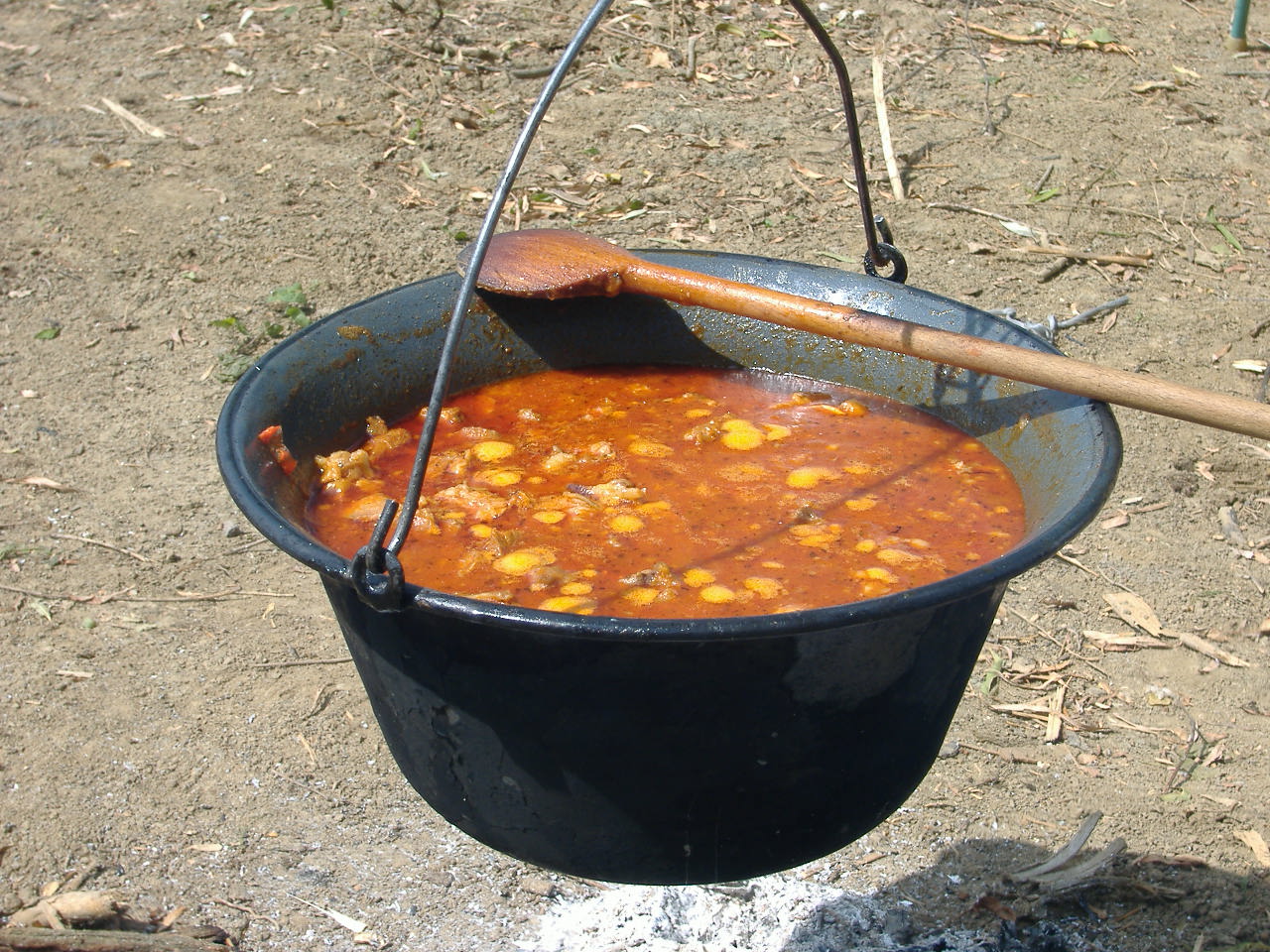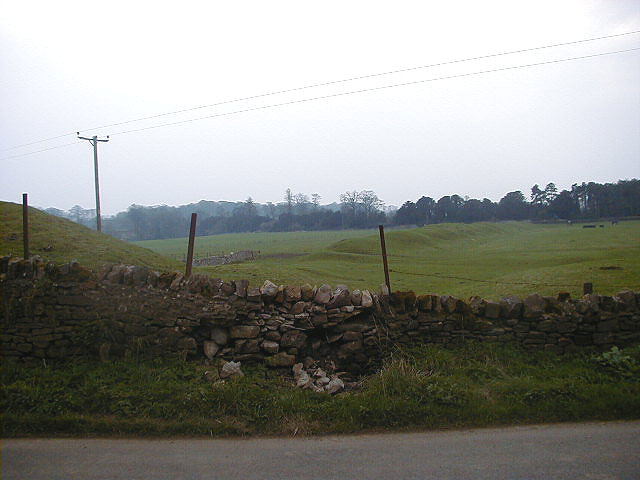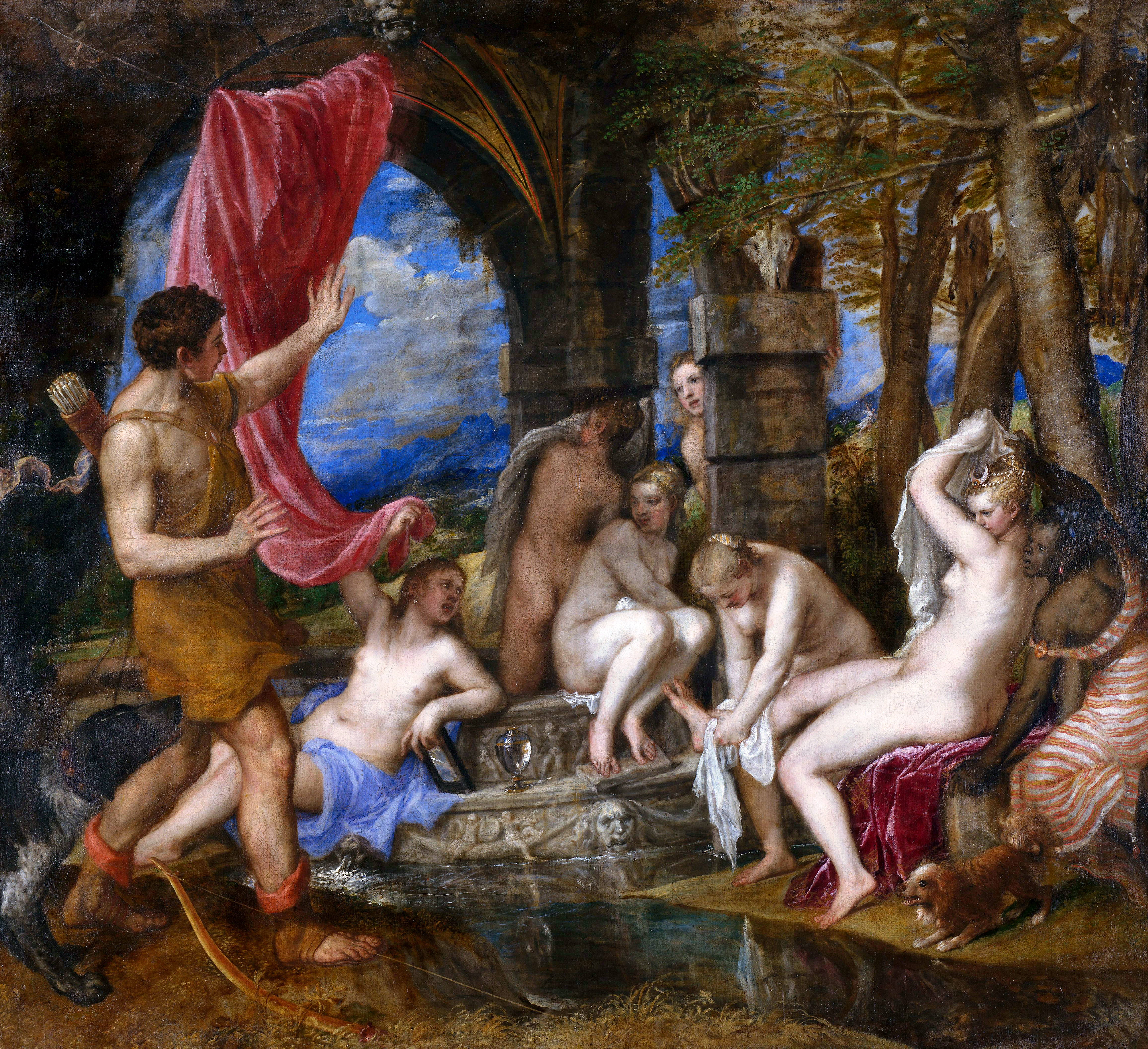|
Melsonby Hoard
The Melsonby Hoard is a hoard of Iron Age items found buried in a field near the village of Melsonby in North Yorkshire, England, by a metal-detectorist in December 2021. Archaeologists from Durham University excavated the site in 2022 with funding from Historic England. The artefacts are from the time of the Roman Empire, and show pottery, weaponry, use of the wheel, metallurgy and status symbolism. The find was publicised in March 2025, coinciding with the temporary display of a number of the items at the Yorkshire Museum in York. Hoard Discovery The hoard was found in a field near the village of Melsonby in North Yorkshire, England, by Peter Heads, an amateur metal-detectorist, in December 2021. It was immediately designated treasure under the Treasure Act 1996. Heads reported his discovery, which led to archaeologists from Durham University excavating the site in 2022. The excavations were assisted by advice from the British Museum and funding from Historic England. Th ... [...More Info...] [...Related Items...] OR: [Wikipedia] [Google] [Baidu] |
Iron Age
The Iron Age () is the final epoch of the three historical Metal Ages, after the Chalcolithic and Bronze Age. It has also been considered as the final age of the three-age division starting with prehistory (before recorded history) and progressing to protohistory (before written history). In this usage, it is preceded by the Stone Age (subdivided into the Paleolithic, Mesolithic and Neolithic) and Bronze Age. These concepts originated for describing Iron Age Europe and the ancient Near East. In the archaeology of the Americas, a five-period system is conventionally used instead; indigenous cultures there did not develop an iron economy in the pre-Columbian era, though some did work copper and bronze. Indigenous metalworking arrived in Australia with European contact. Although meteoric iron has been used for millennia in many regions, the beginning of the Iron Age is defined locally around the world by archaeological convention when the production of Smelting, smelted iron (espe ... [...More Info...] [...Related Items...] OR: [Wikipedia] [Google] [Baidu] |
British Museum
The British Museum is a Museum, public museum dedicated to human history, art and culture located in the Bloomsbury area of London. Its permanent collection of eight million works is the largest in the world. It documents the story of human culture from its beginnings to the present.Among the national museums in London, sculpture and decorative art, decorative and applied art are in the Victoria and Albert Museum; the British Museum houses earlier art, non-Western art, prints and drawings. The National Gallery holds the national collection of Western European art to about 1900, while art of the 20th century on is at Tate Modern. Tate Britain holds British Art from 1500 onwards. Books, manuscripts and many works on paper are in the British Library. There are significant overlaps between the coverage of the various collections. Established in 1753, the British Museum was the first public national museum. In 2023, the museum received 5,820,860 visitors, 42% more than the previous y ... [...More Info...] [...Related Items...] OR: [Wikipedia] [Google] [Baidu] |
Glass Coloring And Color Marking
The appearance of different Color, colors in glass is largely due to the way light interacts with the materials it contains. In an extremely pure glass, without impurities such as bubbles, coloring ions, or crystalline and nano-sized phases, all visible light would pass through, and the glass would appear completely Transparency and translucency, transparent. When such impurities are present, they selectively absorb certain Wavelength, wavelengths of light, resulting in coloured glass. Glass coloring and color marking may be obtained in several ways. # by the addition of ''coloring ions'',Bernard H. W. S. De Jong, Ruud G. C. Beerkens, Peter A. van Nijnatten: "Glass", in: "Ullmann's Encyclopedia of Industrial Chemistry"; Wiley-VCH Verlag GmbH & Co. KGaA, 2002, # by precipitation of nanometer-sized colloids (so-called ''striking glasses'' such as "gold ruby" or red "selenium ruby"),Werner Vogel: "Glass Chemistry"; Springer-Verlag Berlin and Heidelberg GmbH & Co. K; 2nd revised edition ... [...More Info...] [...Related Items...] OR: [Wikipedia] [Google] [Baidu] |
Coral
Corals are colonial marine invertebrates within the subphylum Anthozoa of the phylum Cnidaria. They typically form compact Colony (biology), colonies of many identical individual polyp (zoology), polyps. Coral species include the important Coral reef, reef builders that inhabit tropical oceans and secrete calcium carbonate to form a hard skeleton. A coral "group" is a colony of very many cloning, genetically identical polyps. Each polyp is a sac-like animal typically only a few millimeters in diameter and a few centimeters in height. A set of tentacles surround a central mouth opening. Each polyp excretes an exoskeleton near the base. Over many generations, the colony thus creates a skeleton characteristic of the species which can measure up to several meters in size. Individual colonies grow by asexual reproduction of polyps. Corals also breed sexually by spawning: polyps of the same species release gametes simultaneously overnight, often around a full moon. Fertilized eggs form ... [...More Info...] [...Related Items...] OR: [Wikipedia] [Google] [Baidu] |
Copper Alloy
Copper alloys are metal alloys that have copper as their principal component. They have high resistance against corrosion. Of the large number of different types, the best known traditional types are bronze, where tin is a significant addition, and brass, using zinc instead. Both of these are imprecise terms. Latten is a further term, mostly used for coins with a very high copper content. Today the term ''copper alloy'' tends to be substituted for all of these, especially by museums. Copper deposits are abundant in most parts of the world (globally 70 parts per million), and it has therefore always been a relatively cheap metal. By contrast, tin is relatively rare (2 parts per million), and in Europe and the Mediterranean region, and even in prehistoric times had to be traded considerable distances, and was expensive, sometimes virtually unobtainable. Zinc is even more common at 75 parts per million, but is harder to extract from its ores. Bronze with the ideal percentage of ... [...More Info...] [...Related Items...] OR: [Wikipedia] [Google] [Baidu] |
Chariot
A chariot is a type of vehicle similar to a cart, driven by a charioteer, usually using horses to provide rapid Propulsion, motive power. The oldest known chariots have been found in burials of the Sintashta culture in modern-day Chelyabinsk Oblast, Russia, dated to c. 1950–1880 BC and are depicted on cylinder seals from Central Anatolia Region, Central Anatolia in Kültepe dated to c. 1900 BC. The critical invention that allowed the construction of light, horse-drawn chariots was the spoked wheel. The chariot was a fast, light, open, two-wheeled conveyance drawn by two or more Equidae, equids (usually horses) that were hitched side by side, and was little more than a floor with a waist-high guard at the front and sides. It was initially used for ancient warfare during the Bronze Age, Bronze and Iron Age, Iron Ages, but after its military capabilities had been superseded by Light cavalry, light and Heavy cavalry, heavy cavalries, chariots continued to be used for travel and t ... [...More Info...] [...Related Items...] OR: [Wikipedia] [Google] [Baidu] |
Cauldron
A cauldron (or caldron) is a large cookware and bakeware, pot (kettle) for cooking or boiling over an open fire, with a lid and frequently with an arc-shaped hanger and/or integral handles or feet. There is a rich history of cauldron lore in religion, mythology, and folklore. Etymology The word cauldron is first recorded in Middle English as ''caudroun'' (13th century). It was borrowed from Norman language, Norman ''caudron''T. F. Hoad, ''English Etymology'', Oxford University Press, 1993 (). p. 67. (Picard language, Picard ''caudron'', ). It represents the phonetical evolution of Vulgar Latin ''*caldario'' for Classical Latin ''caldārium'' "hot bath", that derives from ''cal(i)dus'' "hot". The Norman-French word replaces the Old English ''ċetel'' (German ''(Koch)Kessel'' "cauldron", Dutch ''(kook)ketel'' "cauldron"), Middle English ''chetel''. The word "kettle" is a borrowing of the Old Norse variant ''ketill'' "cauldron". History From Latin origin, the term cauldron i ... [...More Info...] [...Related Items...] OR: [Wikipedia] [Google] [Baidu] |
Horse Bit
The bit is an item of a horse's tack. It usually refers to the assembly of components that contacts and controls the horse's mouth, and includes the shanks, rings, cheekpads and mullen, all described here below, but it also sometimes simply refers to the ''mullen'', the piece that fits inside the horse's mouth. The mullen extends across the horse's mouth and rests on the ''bars'', the region between the incisors and molars where there are no teeth. The bit is located on the horse's head by the , and which has itself several components to allow the most comfortable adjustment of bit location and control. The bit, bridle and reins function together to give control of the horse's head to the rider. The bit applies pressure to the horse's mouth, and reinforces the other control signals from the rider's legs and weight distribution. A well schooled horse needs little pressure on the bit from a skilled rider. Studies have indicated that soft, consistent bit contact between the rider ... [...More Info...] [...Related Items...] OR: [Wikipedia] [Google] [Baidu] |
Adornment
An adornment is generally an accessory or ornament worn to enhance the beauty or status of the wearer. They are often worn to embellish, enhance, or distinguish the wearer, and to define cultural, social, or religious status within a specific community. When worn to show economic status, the items are often either rare or prohibitively expensive to others. Adornments are usually colourful, and worn to attract attention. They have a long history, around the world, from feathers or bone, to modern accessories, such as jewellery. Items of adornment are also used by warriors, and by other members of the military to show rank or achievement. Items of adornment These include cosmetics, jewellery, clothing accessories, facial hair, fingernail modification, piercing, lip plates, tattooing, braiding, and headgear. Cultures, subcultures, and institutions Groups who practice adornment include the yakuza, military, religious institutions, tribal groups, and the punk culture. Items of ado ... [...More Info...] [...Related Items...] OR: [Wikipedia] [Google] [Baidu] |
Hillfort
A hillfort is a type of fortification, fortified refuge or defended settlement located to exploit a rise in elevation for defensive advantage. They are typical of the late Bronze Age Europe, European Bronze Age and Iron Age Europe, Iron Age. Some were used in the post-Roman Empire, Roman period. The fortification usually follows the contours of a hill and consists of one or more lines of Earthworks (Archaeology), earthworks or stone Rampart (fortification), ramparts, with stockades or defensive walls, and external ditches. If enemies were approaching, the inhabitants would spot them from a distance. Prehistoric Europe saw a growing population. It has been estimated that in about 5000 BC during the Neolithic between 2 million and 5 million lived in Europe; in the Late Iron Age it had an estimated population of around 15 to 30 million. Outside Greece and Italy, which were more densely populated, the vast majority of settlements in the Iron Age were small, with ... [...More Info...] [...Related Items...] OR: [Wikipedia] [Google] [Baidu] |
Stanwick Iron Age Fortifications
The Stanwick Iron Age Fortifications (also known as 'Stanwick Camp'), a huge Iron Age hill fort, sometimes but not always considered an oppidum, comprising over of ditches and ramparts enclosing approximately of land, are situated in Richmondshire, North Yorkshire, England. Whether Stanwick was the stronghold of Venutius or Cartimandua, or perhaps of them both for a brief time before their acrimonious split some time after 51 AD, it is certain that this settlement was one of the most important in Brigantia, the Brigantes kingdom during the early stages of the Roman occupation of Britain. The site is a scheduled monument. Location and etymology The fortifications are located north of the town of Richmond and south west of Darlington, close to Scotch Corner and the remains of the Roman fort and bridge at Piercebridge. Rising to a height of almost in places, the ramparts completely surround the village of Stanwick St John and form one of the largest Iron Age settlem ... [...More Info...] [...Related Items...] OR: [Wikipedia] [Google] [Baidu] |
Find Spot
Provenance () is the chronology of the ownership, custody or location of a historical object. The term was originally mostly used in relation to works of art, but is now used in similar senses in a wide range of fields, including archaeology, paleontology, archival science, economy, computing, and scientific inquiry in general. The primary purpose of tracing the provenance of an object or entity is normally to provide contextual and circumstantial evidence for its original production or discovery, by establishing, as far as practicable, its later history, especially the sequences of its formal ownership, custody and places of storage. The practice has a particular value in helping authenticate objects. Comparative techniques, expert opinions and the results of scientific tests may also be used to these ends, but establishing provenance is essentially a matter of documentation. The term dates to the 1780s in English. Provenance is conceptually comparable to the legal term ''chain ... [...More Info...] [...Related Items...] OR: [Wikipedia] [Google] [Baidu] |
